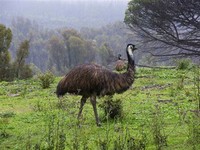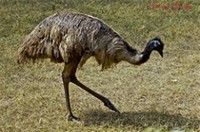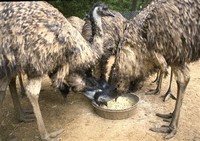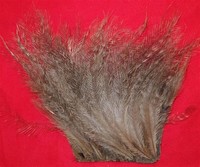Facts about Emu

Emus breed well in captivity, and are kept in large open pens to avoid leg and digestive problems that arise with inactivity.

The emu is classified in the family with their closest relatives the cassowaries in the family Casuariidae in the ratite order Struthioniformes.

Emus were used as a source of food by indigenous Australians and early European settlers.

The Kangaroo Island emu, a separate species, became extinct in the early 1800s, likely as a result of hunting and habitat deterioration.

Emu fat is rendered to produce oil for cosmetics, dietary supplements, and therapeutic products.

Emus were introduced to Maria Island off Tasmania and Kangaroo Island near South Australia during the twentieth century.

The Kurdaitcha man of Central Australia is said to wear sandals made of emu feathers to mask his footprints.

A unique feature of the emu feather is its double rachis emerging from a single shaft.

Emus form breeding pairs during the summer months of December and January, and may remain together for about five months.

The emu is popularly but unofficially considered as a faunal emblem—the national bird of Australia.

Emus live in most habitats across Australia, although they are most common in areas of sclerophyll forest and savanna woodland, and least common in populated and very arid areas.

The small emus—Dromaius baudinianus and D. ater—both became extinct shortly after.

Commercial emu farming started in Western Australia in 1987, and the first slaughtering occurred in 1990 (O'Malley 1998).

Emu meat is a low-fat, low-cholesterol meat (85 mg/100 grams); despite being avian, it is considered a red meat because of its red color and pH value (USDA 2005, 2006).

In Australia, the commercial industry is based on stock bred in captivity and all states except Tasmania have licensing requirements to protect wild emus.

The first verified occurrence of genetically identical avian twins was demonstrated in the emu (Bassett et al.

The isolated emu population of the New South Wales North Coast Bioregion and Port Stephens is listed as endangered by the New South Wales Government (DEC 2005).

The emu was first described under the common name of the New Holland cassowary in Arthur Phillip's Voyage to Botany Bay, published in 1789 (Gould 1865).

Europeans killed emus to provide food and to remove them if they interfered with farming or invaded settlements in search of water during drought.

Emus serve as an important agent for the dispersal of large viable seeds, which contributes to floral biodiversity (McGrath and Bass 1999; Powell and Emberson 1990).

The hats of the Australian Light Horse were famously decorated with an Emu feather plume.

Emus weigh between 30 and 60 kilograms (66–132 pounds) (Ivory 1999).

The emu subspecies that previously inhabited Tasmania became extinct after the European settlement of Australia in 1788.

Reaching up to two meters (6.5 feet) in height, the emu is the largest bird native to Australia and the second-largest extant bird in the world by height, after its ratite relative, the ostrich.

Emus are largely solitary, and while they can form enormous flocks, this is an atypical social behavior that arises from the common need to move towards food sources.

The scientific name for the emu is Latin for "fast-footed New Hollander."

The emu is common over most of mainland Australia, although it avoids heavily populated areas, dense forest, and arid areas.

The pelvic limb muscles of emus have a similar contribution to total body mass as the flight muscles of flying birds (Patak and Baldwin 1998).

Emus have been shown to travel long distances to reach abundant feeding areas.

On exhalation, the emu's cold nasal turbinates condense moisture back out of the air and absorb it for reuse (Maloney and Dawson 1998).

Commercially, emus are farmed for their meat, oil, and leather, and they also provide economic value by eating insects that are agricultural pests.

Wild emus are formally protected in Australia under the Environment Protection and Biodiversity Conservation Act 1999.

The name emu also is used for extinct species belonging to the Dromaius genus, such as the Kangaroo Island emu (Dromaius baudinianus) and the King Island emu (Dromaius ater).

Dactylic hexameter was the traditional meter of Greek epic poetry, the earliest extant examples of which are the works of Homer and Hesiod.

The Emu was an important source of meat to the Aborigines in the areas to which it was endemic.





